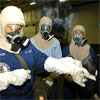
Impurity Profiling Method Tracks Down Chemical Terrorists
Scientists are reporting development of a first-of-its-kind technology that could help law enforcement officials trace the residues from terrorist attacks involving nerve gas and other chemical agents back to the companies or other sources where the perpetrators obtained ingredients for the agent. A report on the technique, which could eventually help track down perpetrators of chemical attacks, appears in ACS’ journal Analytical Chemistry.
Carlos Fraga and colleagues explain that nerve agents, like sarin (also called GB), are some of the most toxic and fast-acting chemical warfare agents in existence. As seen in the 1994 and 1995 GB attacks in Japan, symptoms — such as a runny nose and a tightness in the chest — can appear within seconds, followed by nausea and difficulty breathing. Although traces of the agent remain after such attacks, there has been no practical way of tracing the agent back to its source ingredients. Fraga’s team sought to develop a way to do just that.
Fraga’s group describes a method called “impurity profiling” that identifies impurities in a GB sample at a crime scene and matches them like a fingerprint to the impurities in the source chemicals, pinpointing the likely source. They found that up to 88 percent of the impurities in source chemicals used to make GB can wind up in the finished product, and these impurities are unique, like a fingerprint. Using standard laboratory instruments, they performed impurity profiling and correctly identified the starting materials used for two different batches of GB. “This remarkable outcome may one day become a basis for using impurity profiling to help find and prosecute perpetrators of chemical attacks,” say the researchers.
The authors acknowledge funding from the U.S. Department of Homeland Security.